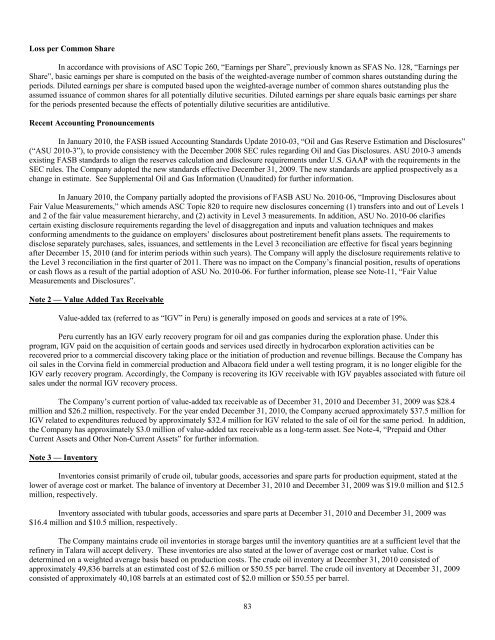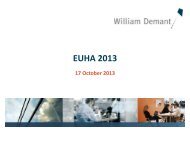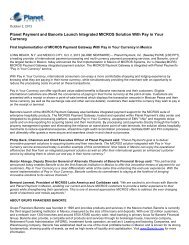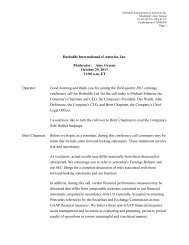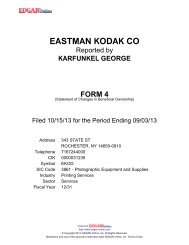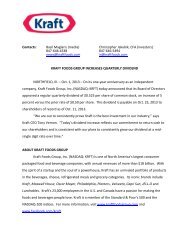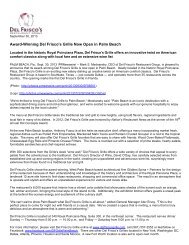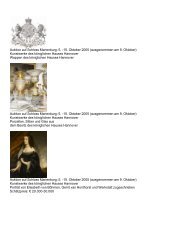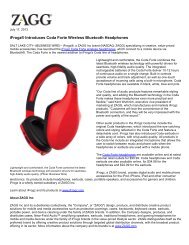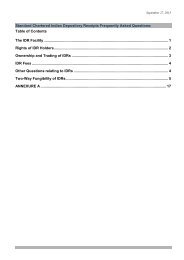BPZ Resources, Inc. - Shareholder.com
BPZ Resources, Inc. - Shareholder.com
BPZ Resources, Inc. - Shareholder.com
Create successful ePaper yourself
Turn your PDF publications into a flip-book with our unique Google optimized e-Paper software.
Loss per Common Share<br />
In accordance with provisions of ASC Topic 260, “Earnings per Share”, previously known as SFAS No. 128, “Earnings per<br />
Share”, basic earnings per share is <strong>com</strong>puted on the basis of the weighted-average number of <strong>com</strong>mon shares outstanding during the<br />
periods. Diluted earnings per share is <strong>com</strong>puted based upon the weighted-average number of <strong>com</strong>mon shares outstanding plus the<br />
assumed issuance of <strong>com</strong>mon shares for all potentially dilutive securities. Diluted earnings per share equals basic earnings per share<br />
for the periods presented because the effects of potentially dilutive securities are antidilutive.<br />
Recent Accounting Pronouncements<br />
In January 2010, the FASB issued Accounting Standards Update 2010-03, “Oil and Gas Reserve Estimation and Disclosures”<br />
(“ASU 2010-3”), to provide consistency with the December 2008 SEC rules regarding Oil and Gas Disclosures. ASU 2010-3 amends<br />
existing FASB standards to align the reserves calculation and disclosure requirements under U.S. GAAP with the requirements in the<br />
SEC rules. The Company adopted the new standards effective December 31, 2009. The new standards are applied prospectively as a<br />
change in estimate. See Supplemental Oil and Gas Information (Unaudited) for further information.<br />
In January 2010, the Company partially adopted the provisions of FASB ASU No. 2010-06, “Improving Disclosures about<br />
Fair Value Measurements,” which amends ASC Topic 820 to require new disclosures concerning (1) transfers into and out of Levels 1<br />
and 2 of the fair value measurement hierarchy, and (2) activity in Level 3 measurements. In addition, ASU No. 2010-06 clarifies<br />
certain existing disclosure requirements regarding the level of disaggregation and inputs and valuation techniques and makes<br />
conforming amendments to the guidance on employers’ disclosures about postretirement benefit plans assets. The requirements to<br />
disclose separately purchases, sales, issuances, and settlements in the Level 3 reconciliation are effective for fiscal years beginning<br />
after December 15, 2010 (and for interim periods within such years). The Company will apply the disclosure requirements relative to<br />
the Level 3 reconciliation in the first quarter of 2011. There was no impact on the Company’s financial position, results of operations<br />
or cash flows as a result of the partial adoption of ASU No. 2010-06. For further information, please see Note-11, “Fair Value<br />
Measurements and Disclosures”.<br />
Note 2 — Value Added Tax Receivable<br />
Value-added tax (referred to as “IGV” in Peru) is generally imposed on goods and services at a rate of 19%.<br />
Peru currently has an IGV early recovery program for oil and gas <strong>com</strong>panies during the exploration phase. Under this<br />
program, IGV paid on the acquisition of certain goods and services used directly in hydrocarbon exploration activities can be<br />
recovered prior to a <strong>com</strong>mercial discovery taking place or the initiation of production and revenue billings. Because the Company has<br />
oil sales in the Corvina field in <strong>com</strong>mercial production and Albacora field under a well testing program, it is no longer eligible for the<br />
IGV early recovery program. Accordingly, the Company is recovering its IGV receivable with IGV payables associated with future oil<br />
sales under the normal IGV recovery process.<br />
The Company’s current portion of value-added tax receivable as of December 31, 2010 and December 31, 2009 was $28.4<br />
million and $26.2 million, respectively. For the year ended December 31, 2010, the Company accrued approximately $37.5 million for<br />
IGV related to expenditures reduced by approximately $32.4 million for IGV related to the sale of oil for the same period. In addition,<br />
the Company has approximately $3.0 million of value-added tax receivable as a long-term asset. See Note-4, “Prepaid and Other<br />
Current Assets and Other Non-Current Assets” for further information.<br />
Note 3 — Inventory<br />
Inventories consist primarily of crude oil, tubular goods, accessories and spare parts for production equipment, stated at the<br />
lower of average cost or market. The balance of inventory at December 31, 2010 and December 31, 2009 was $19.0 million and $12.5<br />
million, respectively.<br />
Inventory associated with tubular goods, accessories and spare parts at December 31, 2010 and December 31, 2009 was<br />
$16.4 million and $10.5 million, respectively.<br />
The Company maintains crude oil inventories in storage barges until the inventory quantities are at a sufficient level that the<br />
refinery in Talara will accept delivery. These inventories are also stated at the lower of average cost or market value. Cost is<br />
determined on a weighted average basis based on production costs. The crude oil inventory at December 31, 2010 consisted of<br />
approximately 49,836 barrels at an estimated cost of $2.6 million or $50.55 per barrel. The crude oil inventory at December 31, 2009<br />
consisted of approximately 40,108 barrels at an estimated cost of $2.0 million or $50.55 per barrel.<br />
83


